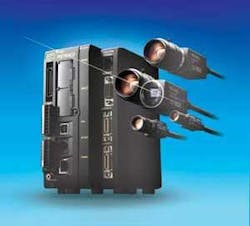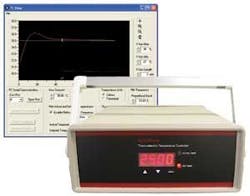Keyence offers machine vision system and machine vision software
Keyence Corp. of America in Woodcliff Lake, N.J., is introducing the CV-5000 machine vision system for high-speed image processing for production lines and other machine vision applications. The 3 + 1 parallel processing system has machine vision software algorithms to detect foreign objects or burrs on irregularly shaped profiles. These machine vision technology algorithms also filter out glare or other background noise. The 11x speed, 5 mega pixel camera transfers images as large as 2,432 by 2,050 pixels in 61.2 milliseconds. Difficult inspections can be done with one camera.
As many as four 5 million-pixel cameras capable of transferring images simultaneously can enable high-definition inspections with resolutions as fine as 20 million pixels. The CV-5000 series also enables simultaneous use of several other camera types. Users can select from a lineup of 14 different models, including standard and mega pixel, as well as high speed standard (640 by 480 pixels) and high speed 2 mega pixel (1,600 by 1,200), which can transfer images in 4.7 and 29.2 microseconds, respectively. An expandable controller architecture enables users to connect extra lighting controllers or camera expansion units without additional PLC programming or wiring. For more information contact Keyence Corp. online at www.keyence.com. Edit this paragraph Assign Image
GeoEye-1 reconnaissance satellite goes operational, says intelligence agency
Imagery from the GeoEye-1 polar-orbiting satellite, launched last September, has been certified as operational by the National Geospatial-Intelligence Agency (NGA), say officials of the satellite’s operator, GeoEye Inc. in Dulles, Va. GeoEye is delivering GeoEye-1 sub-half-meter ground resolution satellite imagery to the NGA. The GeoEye-1 satellite is commissioned. As a result, GeoEye can start charging $12.5 million per June under the terms of a service level agreement with the NGA. “The commercial remote sensing industry can meet a large majority of our national requirements for global mapping and observation, says Bill Schuster, GeoEye’s chief operating officer.”We are already working on the advanced camera and camera electronics for GeoEye-2.” For more information contact GeoEye online at www.geoeye.com.
IPG Photonics introduces green fiber lasers
IPG Photonics, maker of high-power fiber lasers and amplifiers, has developed two new families of fiber lasers in the green spectrum range. At output wavelengths of 532 nanometers, the pulsed 10-Watt green fiber laser and continuous wave (CW) 15-Watt green fiber laser provide a high peak power with scalable average output power up to 10-Watts, pulse duration of 1 nanosecond, and frequency of 50 to 600 kHz. The fiber laser is for applications in the solar/photovoltaic arena, resistor trimming, and marking of transparent materials. Featuring M2 of less than 1.2, the new green pulsed laser includes a collimator, and narrow line width at 532 nm. Higher output powers are planned. The second green fiber laser introduced is a single-frequency and low-noise CW green fiber laser that features output power greater than 15 Watts, M2 of less than 1.1, and a line width near 2 MHz at 532 nm. In a compact, rugged design, the CW green fiber laser is suited for Ti-sapphire pumping.
Aydin Displays supplies rugged flat panels for U.S. Navy CDS program
Video Display Corp.’s Aydin Displays Inc. subsidiary in Atlanta has made its first delivery of first article units (FAUs) for the U.S. Navy Common Displays System (CDS) program. Aydin Displays Inc. won the multiple-year contract to supply the U.S. Navy with 24-inch rugged flat-panel monitors for the CDS program. The contract will provide Aydin displays for the Navy’s CDS consoles in support of the DDG and Aegis Modernization. CDS displays will be used across platform systems on Navy surface ships, submarines, and aircraft. Under its award of one of the largest Naval displays program granted in several years, Aydin Displays has delivered the FAUs nearly 2 Junes ahead of the Navy’s schedule. CDS is designed to meet open architecture and open business model requirements with minimized lifecycle costs that will ensure its interoperability and the ability to handle frequent updates of the latest technology, says a representative. The CDS product family consists of a series of display configurations based on standardized interchangeable components. The CDS displays also provide a robust capability to meet the Navy’s current and future needs for open systems, security features, and cost effectiveness. CDS systems have an intended service life of 30 years.
Thermal imaging specialist OptoTherm introduces high-power thermoelectric controller
Thermal imaging specialist OptoTherm Inc. in Sewickley, Pa., is introducing the HP20 high-power thermoelectric controller for applications in military thermal imaging, electronics, security, and medical. The OptoTherm HP20 provides precise temperature control to within 0.01 degrees Celsius of thermoelectric modules and heating/cooling stages within a temperature range of -40 to 250 C.
The HP20 operates in a bi-directional, H-bridge configuration for smooth transitions between heating and cooling cycles and provides output current as strong as 20 amps at 12 volts DC. The HP20’s PID capabilities enable rapid response to changes in operating conditions and provide tight control over a broad temperature range. TE View, the included PC-based software, provides an intuitive interface for configuring and operating the controller via the controller’s serial (RS-232) interface. For more information, visit OptoTherm online at www.optotherm.com.
Military shortwave infrared cameras benefit from Sensors Unlimited 50 millimeter lens for SWIR cameras
Sensors Unlimited Inc. in Princeton, N.J., is introducing the high performance SWIR optimized 50-millimeter lens for shortwave infrared cameras used for advanced military infrared imaging and other shortwave infrared viewer applications in the 0.7 to 1.7 micron spectral range. The SWIR camera lens is ruggedly designed for military infrared imaging applications, as well as other industrial and commercial infrared camera applications. High performance imaging applications include 24-hour, day and night surveillance (with human recognition at 250-meter range), unmanned aerial vehicles (UAVs), imaging lasers, and driver vision enhancement.
The 50-millimeter focal length lens has a manual locking focus for steady performance with reliable operation and advanced optics that deliver greater than 90 percent throughput from 0.9 to 1.7 microns. It has a fixed aperture at f/1.4 that provides sharp imagery, with low distortion. SWIR stands for shortwave infrared. The SWIR SOLO 50 performs with Sensors Unlimited’s high sensitivity, InGaAs-SWIR, KT and SD camera families. Designed for large focal plane arrays (up to 640-by-512 with a 25-micron pixel pitch), the camera optics are for demanding, low-light-level imaging tasks. For more information contact Sensors Unlimited online at www.sensorsinc.com. Edit this paragraph Assign Image






